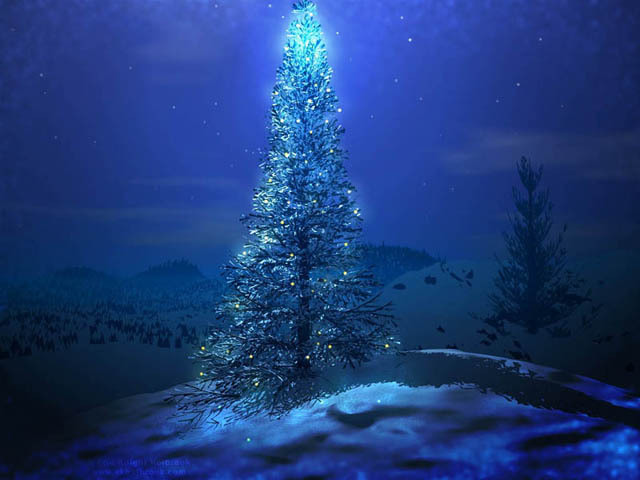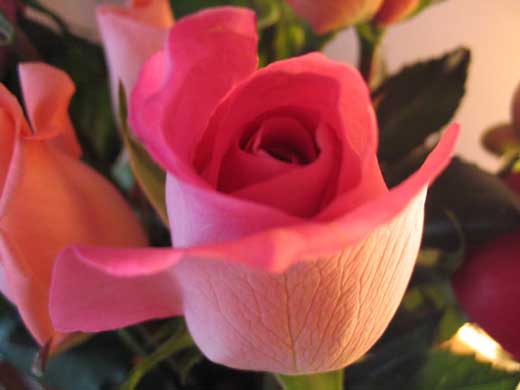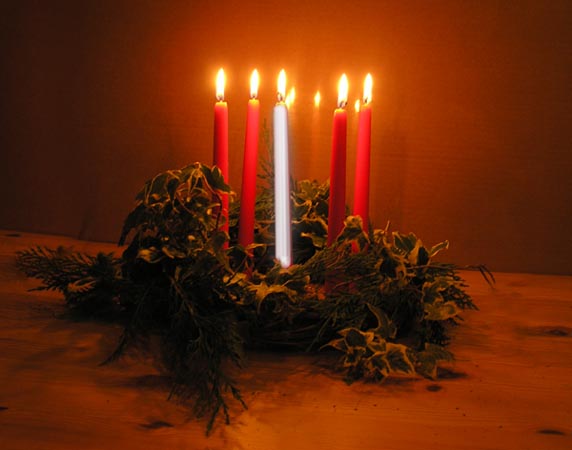Advent: A Way Of Knowing More What God Is Like
By Christopher Hill
Like most of us, I used to think that what children liked about Christmas was the presents. But I was ignoring the evidence of my own experience. Whoever had a Christmas morning that matched Christmas Eve? I now think that what children, and adults, really like about Christmas is the waiting. Or Advent, to give waiting its technical name. Advent is the beginning of the Christian year, when the project of undoing time begins. One of the uses of the Christian year is to train our spiritual senses to see sacraments everywhere, at anytime, to see all experience as potentially revealing something of the sacred to us. We can and should use Advent—waiting for Christmas—as a way of knowing more what God is like.
I don't mean using Advent as is often done in Sunday school classes, when a teacher tries to direct a child's actual experience toward some explicitly religious idea or image. For instance, telling kids that their Advent excitement is "really" about Baby Jesus in the manger. This is simply making one sacrament—the experience of Advent-point to another—the Holy Child of Bethlehem. The confusion that results has nipped many spiritual lives in the bud. It's equivalent to holding up a map of a child's favorite vacation spot and telling her that she ought to feel about the map the way she feels about the beach.
I used to think that what children liked about Christmas was the presents. But I was ignoring the evidence of my own experience. Whoever had a Christmas morning that matched Christmas Eve? I now think that what children, and adults, really like about Christmas is the waiting.
This sort of Sunday school talk doesn't, and can't, tell us what we're waiting for in Advent, any more than a map can tell us why we want to go to the beach. The proper use of a sacrament is to let it tell us what it is about. The Advent complex of season, liturgy, custom, and music has been worked out over a long time to evoke an experience of the Divine. It's all there; it's wonderfully designed. The Church year calls on a library of experiences stored deep in memory. Like a digital sampler, it makes a composition out of these deep feelings and associations, evoking and orchestrating them into a pattern.
Advent calls on us to take seriously the knowledge of childhood—knowledge from the quiet that winter nights lay over the world and the dark purity of the sky and the polished stars. It reminds us of what we knew in the silence of the waiting woods and in the twinkling white lights that shook and flickered on bushes and trees as if the world were putting on elegant clothes. It calls us to remember the growing fullness that pressed in around everything like cotton. It brings to mind that the music we heard and the songs we sang with their tender golden sadness were also full of that presence.
This quiet but electric expectancy gives us a hint of what it means to wait for Christ. "It's what I always wanted," we hope to hear children say on Christmas morning. My guess is that what they always wanted-and what we always want-comes earlier. What children feel during Advent isn't just squirming impatience for a time that's not here yet. They also sense that daily life is being slowly transformed into something more interesting, something with a story to it. One day in Advent, children—and the child in each of us—cross a threshold that separates ordinary, less meaningful time from something trembling with meaning.
This feeling may be caused by the prospect of boxes under the tree. If so, it's a striking example of how something very big can be induced by a very small and humble stimulus, sort of like the grain of sand in an oyster that makes a pearl. This awareness that's being created is the essence of festival, a golden pattern settling over the familiar world and drawing it up into the shape of a story. The magic of Advent is like going to bed in the familiar world and waking up in a story. This magic is part of what we mean by adventus, waiting for Christ.
One of the greatest historical trick-or-treats that God ever played on humans is that Christ did not come back to wrap up history in the late first century, as the early Christians expected. Christ's immanent return was the cornerstone of their faith. That it never happened was God's Zen koan. If you're sure that God is going to establish his presence once and for all in a huge crashing cinemascope parousia (second coming), and it doesn't happen, then where is God? At that point you have to find a different way to think; you have to look in a different direction. Somewhere around the time that Christians dropped the expectation of Christ's immediate return, they began to celebrate Christmas. Advent tells us that in the waiting somehow is finding.
Watching for Christ doesn't mean looking ahead towards the future. Rather, it means looking outside of time, or into our hearts, which is, after all, the direction from which Christ comes.
Is Advent, then, a cosmic bait and switch, a promise that is never fulfilled? It might be, if Advent was the kind of waiting we do in profane time, waiting for a future event that promises to reveal everything. But Advent is not ordinary waiting. Its purpose is to teach us to let go of the hope of finally having. Watching for Christ doesn't mean looking ahead towards the future. Rather, it means looking outside of time, or into our hearts, which is, after all, the direction from which Christ comes. It also means looking at the present with wide and attentive eyes. As John Henry Newman said, they wait for Christ who would not be overly distressed to hear that he is coming now. Newman wasn't thinking about people who are so holy that the thought of judgment doesn't perturb them. He was thinking about people who would not be distressed by the end of time, because they know they will never find their heart's desire inside time. Which, really, is all of us.
Something is coming into the world during Advent. When you bring a Christmas tree indoors, for a while it holds the cold outdoor air. You can feel it among the branches. Something has crossed your threshold from the outside world into the inside world of your home. This big dark green thing with branches sticking out in every direction makes an opening, a channel between two realms of the imagination.
Advent is about the numinous, that felt sense of the Divine or supernatural. C. S. Lewis described the numinous as the difference in our response between being told that there is a tiger in the next room and being told that there is a ghost. That difference in the quality of the fear is the presence of the numinous. The perception of the numinous is a very old human capacity that reveals our spiritual senses to be as innate as our animal senses. Our ancestor's hair stood up not only when they sensed carnivores in the dark, but when they sensed gods. The numinous gives us goose bumps, even when there's no danger, even when what's out there is something very, very good. The Bible is full of examples of this feeling. At the sound of the angels, the shepherds were sore afraid with "the great joy that is also a great fear," as T. S. Eliot says in "The Cultivation of Christmas Trees."
The feel of Christmas, Winter romanticism, precious handicraft and beautiful gifts: The Advent season in the holiday region Alpbachtal Seenland (Austria) is a contemplative time of the year and rich in tradition. Since decades the Alpbachtal Seenland region is known for its beautiful and original Advent markets. The Rattenberg Advent is the main event with a rich and authentic program. The Brixlegg Christmas Market with farmers market (shown here), St. Nicholas and Christ Child procession is extremely popular with all age groups. The age-old custom of the wonderfully gruesome Perchten processions encourage viewers to "touch and marvel."The ominous in Advent is also delicious. In Advent, there is an angel in the next room. Advent is a dramatization of the big truth that there is always something waiting, lurking just beyond the curtains of routine and distraction. Numinousness is the response that our senses register to the near approach of the sacred. But not to a complete appearance. The object of numinous perception is not right here. It is always "in the next room," just about to appear. Always coming. Always Advent. By patient, watchful attendance—the virtues of Advent—upon our experience, the mystery will, "in the fullness of time," make itself known. Time will come to term and deliver eternity.
The pregnancy of Mary is, of course, the gospel image of Advent. The mood of Advent is the expectancy of the mother. At other seasons the spirit ventures out into the colorful, tragic peril of the world. In Advent we stay close to home. There is a quiet sureness with Advent, a hush as the great processes move. We feel what is coming in our hearts. The attention turns inward, into what Dylan Thomas called the close and holy darkness.
Einstein said that the fairest thing we can experience is the mysterious, and he was right. On the intellectual level, a mystery is something we don't understand but that we will, or at least can, understand. Advent is a very fair and mysterious experience, but its mystery is not the kind that we don't understand; it's the kind we can't understand. But we can know it. The icon of Advent is candlelight in darkness. The light in the center of the darkness is the light of the heart. To the mind, mystery is an impenetrable darkness. But what is dark to the mind is light in the heart. The patience and watchfulness of Advent is a program to develop a kind of spiritual perceptiveness that is only possible when the mind is quiet and waiting.
In prayer as it's taught in the Eastern Church, attention is drawn away from the exterior world and focused in the heart. In Advent, the life of the world has drawn back inside. In these days of early winter, the light-infused world of summer shrinks until it is condensed into the fire on the hearth, a candle in a window, pinpoint white lights on trees that are darker than the night around them. As Thomas Merton wrote:
. . . minds as meek as beasts,
Stay close at home in the sweet hay;
And intellects are quieter than the flocks that feed
by starlight.The earth in its turning has balanced its axis squarely on the sun. The sun that creates our time by its journey across the sky barely moves. The long days of summer have focused as narrowly as they can. We are approaching the still point of the turning world, and the world knows it.
The Advent wreath: each candle in the wreath represents one of the four Sundays of Advent (three purple or read, and a rose candle on the third Sunday) with a fifth candle (white) to be lit on Christmas Day. The first candle is traditionally the candle of Expectation or Hope. The second candle is for Love, the third candle stands for Joy, and the final candle is lit on the final Sunday of Advent for Peace.One Advent, I got up early on a Saturday and took our dog out for a walk. A dusting of snow blew back and forth across the sidewalk. I could hear a neighbor's wind chimes. We went into the woods down the railroad tracks from our house. As we came out into a clearing by a gully, we were engulfed in quiet: the woods, even the crows, were completely quiet. The only sound was the creaking of the trees in the wind. Off on the hill on the other side of the gully were two children. I could see the bright colors of their jackets, flickering between the gray trees.
The sense of waiting was dense. Something enormous was developing. The stillness was not an absence of activity; it was taut. The woods were holding themselves still, in "a passion of patience," as Charles Williams said. They felt like an empty room waiting for someone to come in. I don't think the woods always felt that way at this time of year. I think that all the Advents that humans ever had were working together to create that moment, to wear away a weak spot in time where eternity could break through.
In the early winter woods, or down the empty streets of your neighborhood, in the iron December wind, you can still feel the big thing that's coming, an unbroken thread of feeling from your earliest childhood. On the time line, your childhood is behind you. But in the spiraling Year of the Lord, you've come around to the point on the spiral where all your Advents are layered one on top of the other. As it was in the beginning—in your beginning—it is now and ever shall be. Jesus said we have to become as little children to enter the kingdom of Heaven. With every turning year, the invitation comes again.
Founder/Publisher/Editor: David McGee
Contributing Editors: Billy Altman, Laura Fissinger, Christopher Hill, Derk Richardson
Logo Design: John Mendelsohn (www.johnmendelsohn.com)
Website Design: Kieran McGee (www.kieranmcgee.com)
Staff Photographers: Audrey Harrod (Louisville, KY; www.flickr.com/audreyharrod), Alicia Zappier (New York)
E-mail: thebluegrassspecial@gmail.com
Mailing Address: David McGee, 201 W. 85 St.—5B, New York, NY 10024




